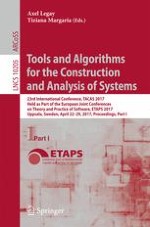2017 | Buch
Tools and Algorithms for the Construction and Analysis of Systems
23rd International Conference, TACAS 2017, Held as Part of the European Joint Conferences on Theory and Practice of Software, ETAPS 2017, Uppsala, Sweden, April 22-29, 2017, Proceedings, Part I
herausgegeben von: Axel Legay, Tiziana Margaria
Verlag: Springer Berlin Heidelberg
Buchreihe : Lecture Notes in Computer Science
